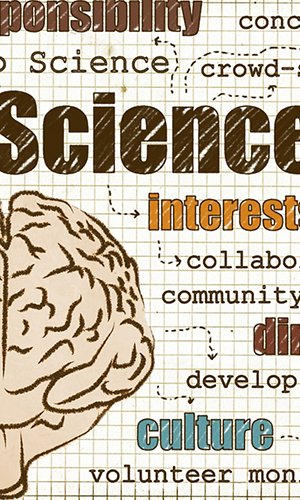There is an old proverb that says “the apple does not fall far from the tree ”.
Apparently it seems perfectly true: the product of something or someone is quite naturally similar to what generated it. As we observed in the previous special report, however, with regard to scientific terms, this is not always so true. Often in fact, the meaning of the term is modified or even substituted with something completely different, and so the word takes on a meaning that can lead to wrong ideas of the world around us. One of the most commonly used terms that is at the same time misunderstood is, for example, “biological”.
Voice search

What language does science speak? 2nd part
Natural – Organic food
In fact today there is a constellation of terms that accompany the word “biological” such as “chemical-free”, “natural” and “organic”.
Often this adjective is connected to the idea that these products have better nutritional values than those from traditional agriculture, as they are pesticide-free and therefore they are safer.
Analyzing these aspects, in his blog for Le Scienze, the Italian edition of Scientific American, the chemist Dario Bressanini explains how they are wrong. In fact he illustrates how the collection of all the published studies that are inherent to a comparison of the nutritional contents in traditional and biological agriculture, from 1958 to date, have not shown, except in some particular cases, any substantial nutritional differences. Likewise, many people believe that biological agriculture does not use pesticides. Actually synthetic pesticides cannot be used, but some pesticides of natural origin are. These however, even though they are not synthetic, can still have an impact on the environment that is not entirely negligible. For example, copper salts are toxic and difficult to eliminate when they accumulate in the ground, but are however used as fungicides. The use of this term to indicate food that does not contain “synthetic” or “chemical” substances, as a synonym of “safe” and “healthy” food that is not harmful, in general, is therefore wrong. On the contrary products may be “synthetic”, but safe and at times they may even be the best choice. Just think of insulin that is principally produced from genetically modified bacteria, and it saves a large number of lives every year, notwithstanding the GMO which are always greatly criticized.
But, what are Genetically Modified Organisms?
In order to understand what they are better, we must first examine two concepts further:
Genes
The first concept is the Gene, that was first coined in 1909 by W.L. Johannsen, a Danish botanist and geneticist who defined it a unit of heredity localized on the chromosomes which, through interaction with the internal and external environment, controls the development of a character or phenotype, and which can self-replicate and can be transferred to the offspring. He too was not very good at providing simple explanations, so let us try to take a step back. Our Instructions Manual, for building and operating our body, from when we are a simple embryo to when we become adults, is deposited in every nucleus of each of our cells. In man, it consists of 46 volumes, the chromosomes, divided into chapters, the genes. These chapters are written with four fundamental complementary letters, in pairs, (A complementary to T, C complementary to G) which, combined with one another, form the sequence called DNA. This is a molecule formed by two filaments: one, made of a long sequence of the letters mentioned above, the other consisting of their exact complements. This sequence that can be more or less long, forms a Gene. And just like the chapters of a book, they can be of variable lengths, and so, also the number of letters composing a gene varies depending on the instructions contained in it. This information , depending on how it is written, can determine, for example, the colour of our eyes or of our hair. Each chapter contains the instructions to build or to operate a part of our body. Just like two paragraphs, with the same title, can describe the same topic using a completely different text, also the genes do so for the same function, e.g. colour of the eyes, they can determine the colour of the eyes even though it is written in a different manner, blue, brown, green. The different versions of the same gene (chapter) are known as alleles. A great misunderstanding regarding genes lies in the way they are always referred to, as “genes of …”. Among the various examples, the Italian daily newspaper, Corriere della Sera, entitled an article “Scoperto il gene che ci fa innamorare” (The gene of making us fall in love has been discovered), transforming the title in Le Scienze, in which an article began with, “Discovery of the association between the OXTR gene (that regulates oxytocin) and a mother’s love”. Just as in this case, on the Internet it is quite easy to find references to “the genes of faithfulness” or “genes of happiness”. When a genetic variation is correlated to something, it becomes the gene of that something. Linguistically it is suggested that, for example, “a particular gene provokes cardiovascular diseases”, when actually it usually means that “those who have this allele seem to be affected more often by heart diseases, but we do not know why and perhaps there are some advantages that compensate these heart diseases, that we have not noticed because we were not looking for them”.
Evolution
The second concept that must be explained after the gene is the concept of Evolution. In the classic sense, by this term we mean, “a more or less directional change in an object, situation, movement, etc. that implies an improvement in the functionality, structure, etc.”
When applied to biology, this term has a more specific meaning, and indicates “a casual change determined by one or more nucleotide substitutions, leading to a change in the gene-phenotype tested by natural selection”.
In order to explain this definition we must refer to what we have just learnt about genes. As in every good book, in fact, also the entire instructions manual (chromosome) of a cell is totally re-written every time it is duplicated so that even the newly born cell has all the indications it needs to grow and operate at its best. In old medieval monasteries the amanuenses or copiers used to copy entire books, in the same way the genetic code is copied through a process called PCR. Every now and then, however, it occurs that these microscopic amanuenses make a small transcription error when copying and they write a word wrong. In these cases the chapter remains comprehensible, and therefore it does not involve any changes in the instructions, or it can be dangerous, leading to a misunderstanding of that chapter by the cell, and therefore the death of the same if not of the entire organism. It may also occur that the chapter is used with a meaning that is slightly different, with a kind of “synonym” of the original word. In this latter case, the change may lead to an improvement in the function that is carried out by that gene, for example running faster, jumping higher or growing wider leaves. In this case the organisms with this change will survive better than those which do not have it, and in thousands of years, in geologic times, only the new gene which is more functional than the old one will be passed on. In some cases this change which is apparently better, leads to a worsening in the function, and consequently is lost, following the death of that organism. Charles Darwin defined the force that selects which errors are useful and which are not, and called it “Natural Selection”. In fact, over thousands of years this force has “defined” which transcription errors were useful and which were not. Through the generations descending from a common ancestor, the sum of these errors has therefore brought to the writing of completely new chapters which however deal with the same topic. As a result of the sum of these errors, from a small anthropomorphic monkey which lived in Africa, the Homo habilis subsequently appeared on the Earth, followed by the Homo erectus, up to the present Homo sapiens : Us.
GMO
So, given the above two preliminary statements, we can return to the previous question: what are Genetically Modified Organisms?
Since time immemorial man has toiled the land and tamed animals. The first domestic animal that is known of, seems to be the dog, tamed around 14,000 BC by the populations of hunters-pickers in Northern Europe, and a few thousand years later in North Eastern Asia. We can date the discovery of agriculture even further back, to the year 23,000 BC. Primitive man started to plant seeds after having repeatedly observed the life cycle of plants. Storing some of the seeds that were collected, and subsequently planting them, were the first steps in cultivating land. From that moment onwards the history of GMO began. Initially this was an unconscious process, but over the centuries it has become increasingly predominant and it also has a driving force in animal farming and in agriculture.
The mechanism underlying GMO is what has driven man to grow larger fruit and faster dogs. By choosing the better larger fruit, and animals that responded better to human requirements, i.e. animals that were more docile and fatter, man has shaped the organisms according to his needs. This is the mechanism that primitive men exploited unknowingly to modify animals and plants. In this way man has carried out the function of Natural Selection. He has decided which “synonyms” were best suited to his needs, abandoning those which did not guarantee a good subsistence. However, selection carried out by nature is on a geologic scale, which therefore implies very long periods of time. And, even though the selection carried out starting from primitive man up to now has been the more rapid one, it is still however very slow. As a consequence we have learnt to make this process more rapid with the help of technological innovations which took place between the Twentieth and the beginning of the Twenty-first century, and we are able to write the “right words” and insert them in an organism. In this manner we can rewrite the chapters, using synonyms, the same way our ancestors modified their animals and plants according to their needs. The “Natural Selection” takes place by testing these synonyms thousands and thousands of times before making these products available when these products are safe and not noxious. Actually, Dario Bressanini indicates that insect-resistant genetically modified maize is apparently even more healthy for human beings, because it has a lower content of toxins (fumonisin) which, instead, are present in greater quantities in both the conventional and the biologic types of Italian maize. Furthermore GMOs can help the poor countries to improve their agricultural production, with a decrease in crop losses, an increase in the farmers’ profits and a strong decrease in the use of pesticides for millions of small farmers. An example is insect resistant Bt cotton, which has had a remarkable diffusion and impact in the developing countries which have decided to grow it. Conventional cotton crops use a large amount of pesticides, with effects that are often harmful for the environment and for the farmers. The World Bank has declared that it has been a success on three fronts: it has increased the profits of the crops and has decreased the losses, and it has also decreased the use of pesticides that were harmful for the farmers’ health.
Just like cotton and maize have “learnt” to defend themselves from insects, insulin is synthetized as a result of instructions implanted in some bacteria which consequently have “learnt” to synthesize it. Like insulin, there are many other substances that we commonly use, that are synthetized and that make our life easier – just think of drugs and all the substances that are present in nature only in small quantities and that need a geologic time to form. The latter face further diffidence because of the incomprehensible amount of time it takes for them to form. Many realize that very long periods are required, but the quantities are so large that they are often too abstract to be comprehensible.
Geologic time
For our mind, which is used to finite and definite objects, one of the most difficult things to understand is numbers that are extremely big, or better the real proportions between them, in this case, the measurement of geologic time. This difficulty lies in their extremely large size when compared to what we compare them with: i.e. the human life-span. It is generally known that, for example, the Earth was formed about 4.5 billion years ago, that sharks swim in the oceans since approximately 400 million years, and that our most primitive ancestors, the first belonging to the genus Homo, date back to about 2.5 million years ago. These numbers are very big, and also quite abstract. And so we must use more tangible units of measure: if for example a year is one centimetre long, to see the birth of our dear Earth we would have to cover a distance of approximately 45 thousand kilometres, approximately the size of the equator, and to swim with one of the first sharks we would have to travel approximately 4000 kilometres, about four times the distance from Aosta to Bari, and in order to observe how the dinosaurs lived, we would have to travel 2300 kilometres, the distance between Lecce and London, and if finally we want to see one of our most ancient ancestors, one of the first humans that walked on the Earth’s surface, we would have to travel 25 kilometres. This seems quite a short journey, but if we optimistically consider a life span of 100 years, we would have to travel 25,000 metres to reach the first men.
All these terms “have fallen far from the tree ” they grew on and they are one of the problems that make science more distant from those who are not experts in the field. If we trust the terms as they are used in common usage, in fact we will look at “the finger pointing to the moon, instead of looking at the moon”, and therefore we will misunderstand the events, consequently provoking a detachment from whatever orbits in the world of science. This way, in fact, we find a false freedom of opinion, which is however linked to a wrong definition that leads us to a wrong opinion, a priori. If instead we understand what they really mean, we could have an idea of the facts and researches reported in the newspapers and television news broadcasts, and therefore would avoid being conditioned by any wrong interpretation given by someone else. At that stage we can decide, independently, if what is reported by the media coincides with our thoughts or not, if we prefer a product to another or if a research may have negative aspects, following a more correct logic.
References
- Italian National Agency for the Evaluation of Universities and Research Institutes (ANVUR), 2014 – Report on the state of (Italian) universities and research institutes
- Smith-Spangler, Crystal, et al. “Are organic foods safer or healthier than conventional alternatives? A systematic review.” Annals of Internal Medicine 157.5 (2012): 348-366. http://media.dssimon.com/taperequest/acp75_study.pdf
- Bressanini D., Dieci vero o falso sul biologico, Blog Le Scienze (in italian)
- Bressanini D., Dieci risposte a Carlo Petrini sugli OGM, Blog Le Scienze (in italian)
By di Davide Poli



